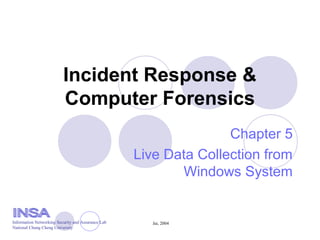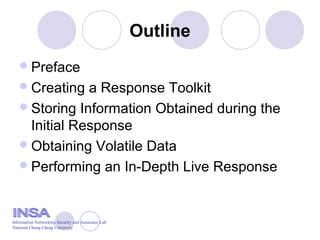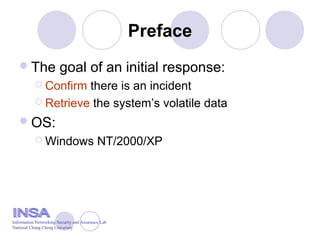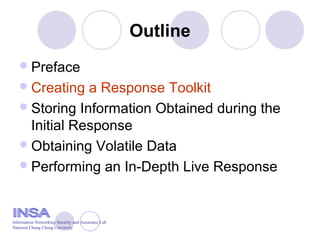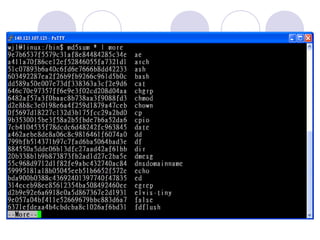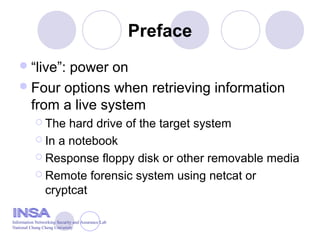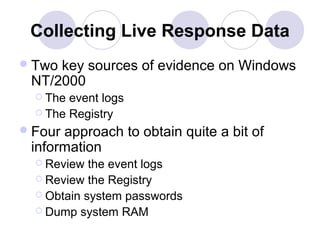Live data collection_from_windows_system
- 1. Jai, 2004 Incident Response & Computer Forensics Chapter 5 Live Data Collection from Windows System Information Networking Security and Assurance Lab National Chung Cheng University
- 2. Outline Preface Creating a Response Toolkit Storing Information Obtained during the Initial Response Obtaining Volatile Data Performing an In-Depth Live Response Information Networking Security and Assurance Lab National Chung Cheng University
- 3. Outline Preface Creating a Response Toolkit Storing Information Obtained during the Initial Response Obtaining Volatile Data Performing an In-Depth Live Response Information Networking Security and Assurance Lab National Chung Cheng University
- 4. Preface The goal of an initial response:  Confirm there is an incident  Retrieve the system’s volatile data OS:  Windows NT/2000/XP Information Networking Security and Assurance Lab National Chung Cheng University
- 5. Outline Preface Creating a Response Toolkit Storing Information Obtained during the Initial Response Obtaining Volatile Data Performing an In-Depth Live Response Information Networking Security and Assurance Lab National Chung Cheng University
- 6. Preface Don’t affecting any potential evidence  Prepare a complete response toolkit A live investigation is not the time to create or test your toolkit for the first time!!! Information Networking Security and Assurance Lab National Chung Cheng University
- 7. cmd.exe The command prompt for Windows NT/2000/XP Built in PsLoggedOn A utility that shows all users connected locally and remotely www.foundstone.com rasusers Show which users have remote- access privilege on the target system NT Resource Kit (NTRK) netstat Enumerate all listening ports and all current connections to those ports Built in Fport Enumerate all processes that opened any TCP/IP ports on a windows NT/2000/XP www.foundstone.com Pslist Enumerate all running processes on the target system www.foundstone.com ListDLLs List all running processes (command-line argument, DLLs) www.foundstone.com nbtstat List the recent NetBIOS connections for approximately the last 10 mins Built in arp Show the MAC addresses of the systems that the target system has been communicating Built in kill Terminate a process NTRK
- 8. md5sum Create MD5 hashes for a given file www.cygwin.com rmtshare Dsiplay the shares accessible on a remote machine NTRK netcat Create a communication channel between two different systems www.atstake.com/research/tool s/network_utilities cryptcat Create an encrypted channel of communication http://Sourceforge.net/projects/c ryptcat PsLogList Dump the contents of the event logs www.foundstone.com ipconfig Display interface configuration information Built in PsInfo Collect information about the local system built www.foundstone.com PsFile Show files that are opened remotely www.foundstone.com PsService Show information about current processes and threads www.foundstone.com auditpol Display the current security audit settings NTRK doskey Display the command history for an open cmd.exe shell Built in
- 9. Preparing the Toolkit Label the response toolkit media  Case number  Time and date  Name of the investigator who created the response media  Name of the investigator using the response media Information Networking Security and Assurance Lab National Chung Cheng University
- 10. Preparing the toolkit Check for dependencies with Filemon  Determine which DLLs and files your response tools depend on Create a checksum for the response toolkit  md5sum Write-protect any toolkit floppies Information Networking Security and Assurance Lab National Chung Cheng University
- 12. Outline Preface Creating a Response Toolkit Storing Information Obtained during the Initial Response Obtaining Volatile Data Performing an In-Depth Live Response Information Networking Security and Assurance Lab National Chung Cheng University
- 13. Preface “live”: power on Four options when retrieving information from a live system  The hard drive of the target system  In a notebook  Response floppy disk or other removable media  Remote forensic system using netcat or cryptcat Information Networking Security and Assurance Lab National Chung Cheng University
- 14. Transferring Data with netcat Two advantage  Get on and off the target system quickly  Perform an offline review Information Networking Security and Assurance Lab National Chung Cheng University
- 15. Transferring Data with netcat NT System Forensic System Time date loggedon fport pslist nbtstat -c 123 1: Run trusted commands on NT Server 2: Send output to forensics box via netcat 3: Perform off-line review md5sum output files
- 16. Transferring Data with netcat  Forensic workstation  Target system Information Networking Security and Assurance Lab National Chung Cheng University
- 17. Encrypting Data with cryptcat Has the same syntax and functions as the netcat command  Sniffer cannot compromise the information you obtain  Eliminates the risk of contamination or injection of data Two-man integrity rule Information Networking Security and Assurance Lab National Chung Cheng University
- 18. Outline Preface Creating a Response Toolkit Storing Information Obtained during the Initial Response Obtaining Volatile Data Performing an In-Depth Live Response Information Networking Security and Assurance Lab National Chung Cheng University
- 19. Preface At minimum, volatile data prior to forensic duplication  System date and time  A list of the users who are currently logged on  Time/date stamps for the entire file system  A list of the currently running processes  A list of the currently open sockets  The applications listening on open sockets  A list of the systems that have current or had recent connections to the system Information Networking Security and Assurance Lab National Chung Cheng University
- 20. Organizing and Documenting Your Investigation Start Time Command Line Trusted Untrusted MD5 Sum of Output Comme nts 12:15:22 type lmhosts | nc 192.168.0.1 2222 X 3d2e531d.655 3ee93e08900 91.3857eef3 12:15:27 pslist | nc 192.168.0.1 2222 X 1ded672ba8b 2ebf5beef672 201003fe8 12:15:32 netstat –an | nc 192.168.0.1 2222 X 52285a23111 332453efe292 343857eef3 Information Networking Security and Assurance Lab National Chung Cheng University
- 21. Collecting Volatile Data Top-ten list of the steps to use for data collection  Execute a trusted cmd.exe  Record the system time and date  Determine who is logged in to the system (and remote-access users, if applicable)  PsLoggedOn  rasusers  Record modification, creation, and access times of all files  dir /?
- 22. Collecting Volatile Data ÔÇ° Determine open ports ÔŨ netstat ÔÇ° List applications associated with open ports ÔŨ Fport ‚Ä¢ winpop.exeÔÉÝNetbus trojan ‚Ä¢ windll.exeÔÉÝGirlFriend trojan ÔÇ° List all running processes ÔŨ Pslist ÔÇ° List current and recent connections ÔŨ netstat ÔŨ arp ÔŨ nbtstat
- 23. Collecting Volatile Data  Record the system time and date  Sandwich your data-retrieval commands between time and date commands  Document the commands used during initial response  doskey /history Scripting your initial response Information Networking Security and Assurance Lab National Chung Cheng University
- 24. Outline Preface Creating a Response Toolkit Storing Information Obtained during the Initial Response Obtaining Volatile Data Performing an In-Depth Live Response
- 25. Preface Find evidence and properly remove rogue programs without disrupting any services Information Networking Security and Assurance Lab National Chung Cheng University
- 26. Creating an In-Depth Response Toolkit auditpol Determin the audit policy on a system NTRK reg Dump specific information (keys) within the NT/2000 Registry NTRK regdump Dump the Registry as a text file NTRK pwdump3e Dump the SAM database so that the passwords can be cracked www.polivec.com/pwdump3.htm l NTLast Monitor successful and failed logons to a system www.foundstone.com Sfind Detect files hidden within NTFS file streams www.foundstone.com Afind Search a file system to determine files accessed during specific timeframes www.foundstone.com dumpel Dump the NT/2000 event logs NTRK
- 27. Collecting Live Response Data Two key sources of evidence on Windows NT/2000  The event logs  The Registry Four approach to obtain quite a bit of information  Review the event logs  Review the Registry  Obtain system passwords  Dump system RAM
- 28. Review the event logs auditpol NTLast dumpel Information Networking Security and Assurance Lab National Chung Cheng University
- 29. Successful logons Information Networking Security and Assurance Lab National Chung Cheng University
- 30. Enumerate failed console logons Information Networking Security and Assurance Lab National Chung Cheng University
- 31. List all successful logons from remote systems Information Networking Security and Assurance Lab National Chung Cheng University
- 32. Review the Registry regdump  Create an enormous text file of the Registry reg query  Extract just the Registry key values of interest Information Networking Security and Assurance Lab National Chung Cheng University
- 33. Obtaining System Passwords pwdump3e  Dump the passwords from the Security Accounts Manager (SAM) database Information Networking Security and Assurance Lab National Chung Cheng University
- 34. Dumping System RAM userdump.exe (MS OEM Support Tools) Two types of memory  User mode (application) memory  Full-system memory Information Networking Security and Assurance Lab National Chung Cheng University

